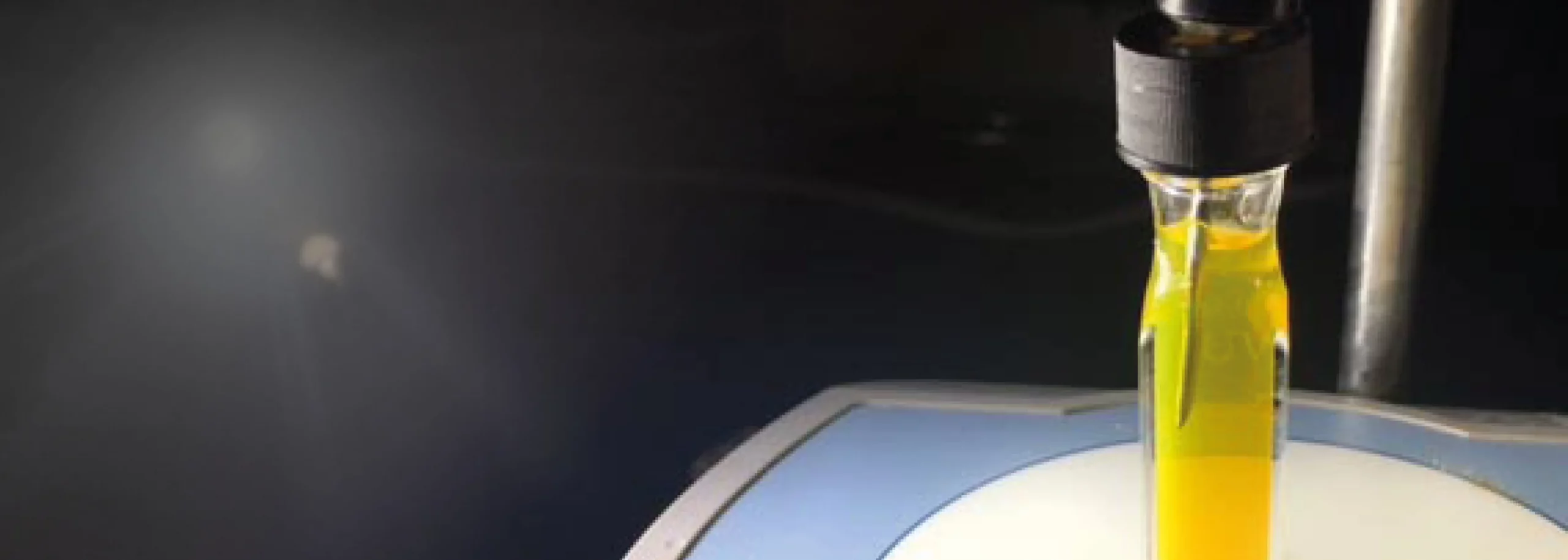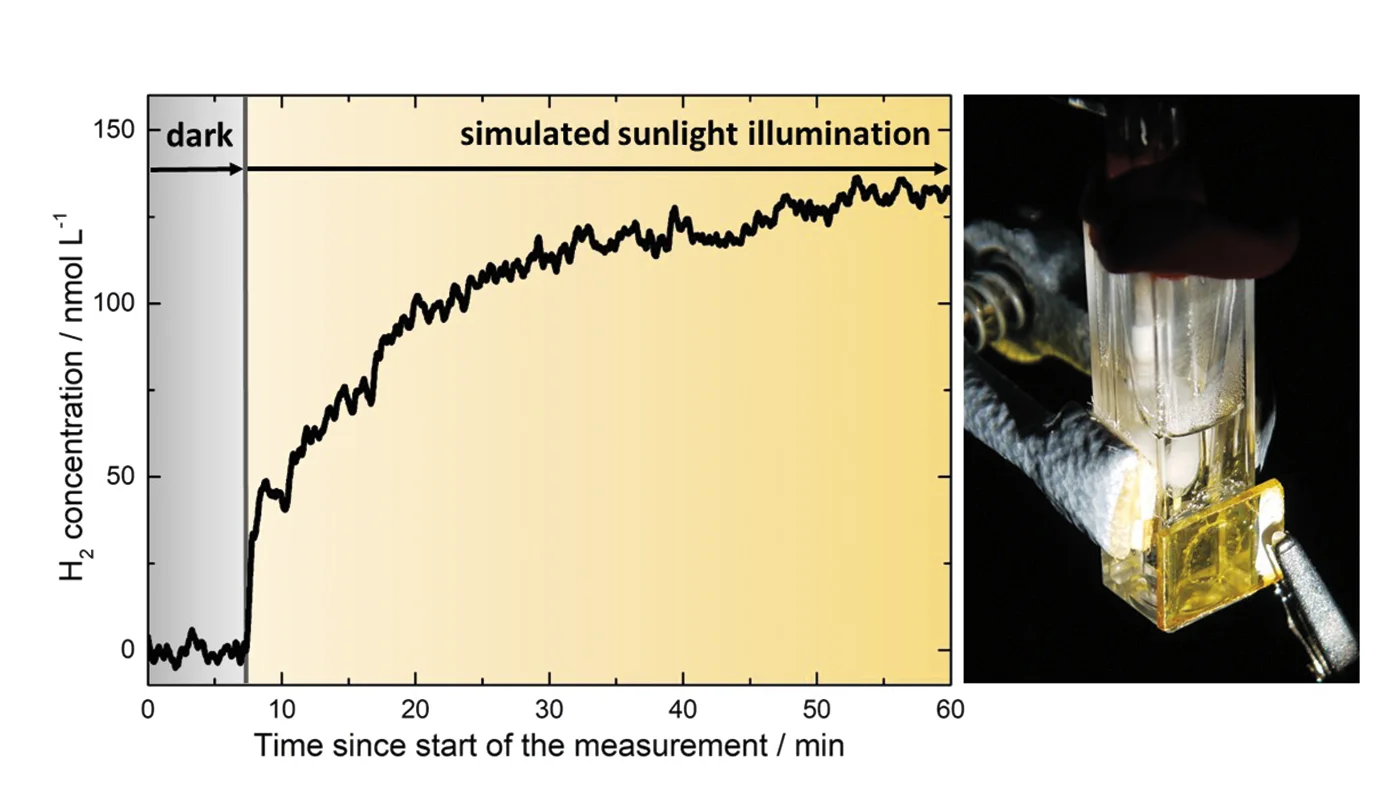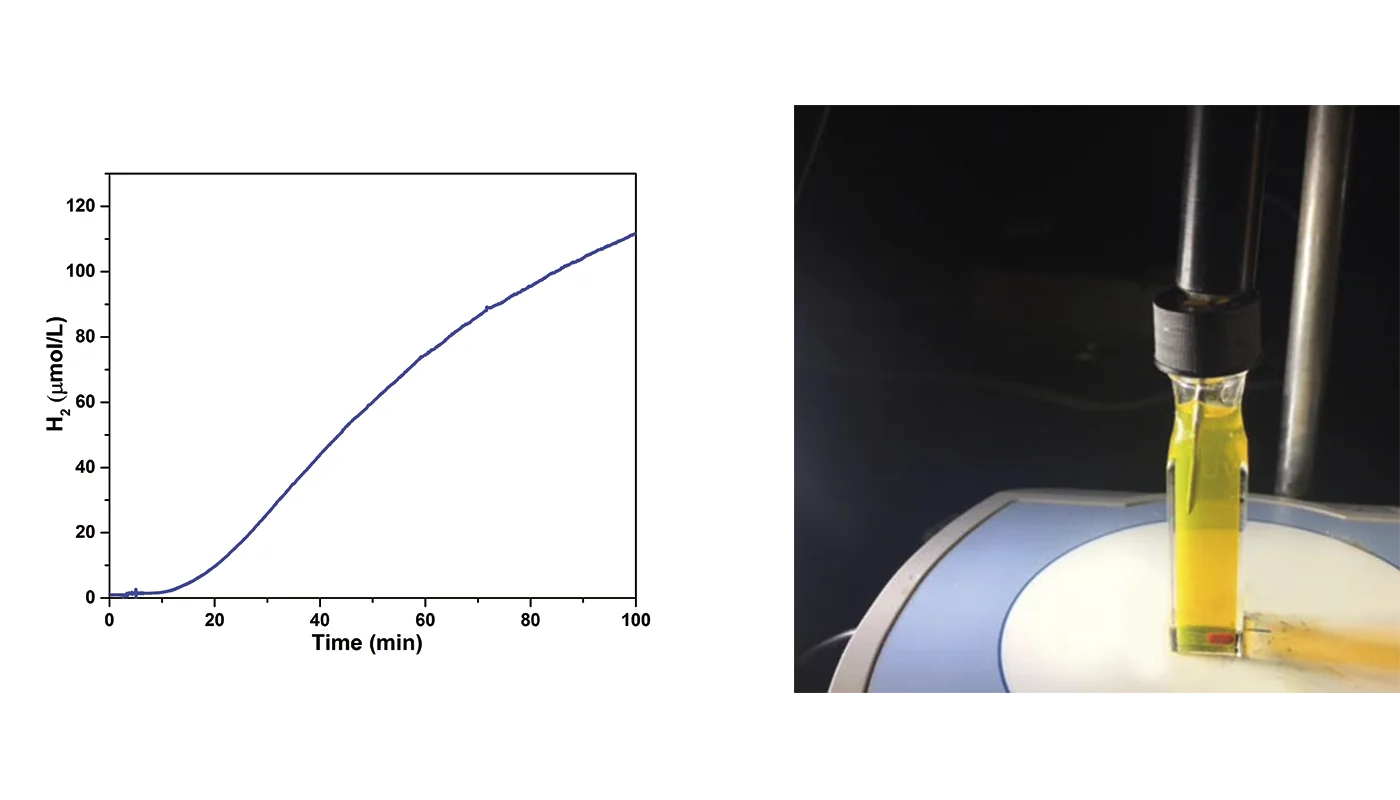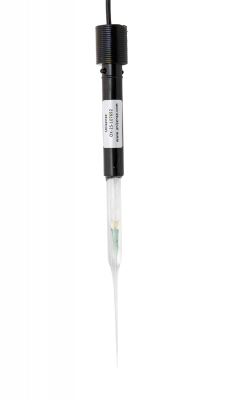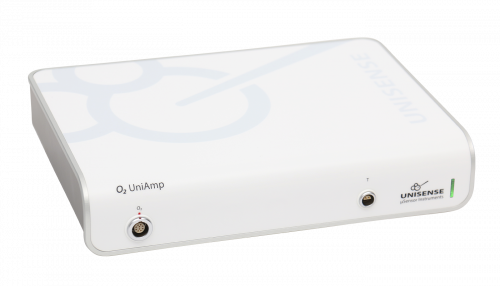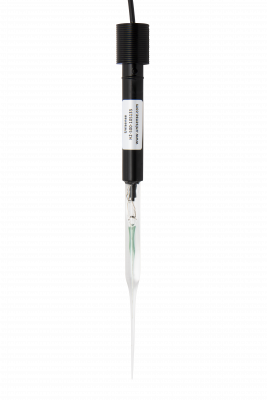Hydrogen evolution by a photoelectrochemical cell based on a Cu2O-ZnO-[FeFe] hydrogenase electrode
Tian, Lei et al. (2018),
Journal of Photochemistry and Photobiology A: Chemistry,
vol. 366,
27-33
Tian, Lei, Németh, Brigitta, Berggren, Gustav, Tian, Haining (2018),
Journal of Photochemistry and Photobiology A: Chemistry,
vol.
366,
27-33
A Cu2O-ZnO-hydrogenase photocathode possessed enzyme/semiconductor junction has been constructed by immobilizing a biological protein catalyst, hydrogenase-CrHydA1 enzyme on the ZnO protected Cu2O electrode. With light illumination, a photocurrent of 0.8 mA/cm2 at 0.15 V vs. RHE was obtained and hydrogen was successfully detected from the photocathode in photoelectrochemical measurements with Faradaic efficiency of ca. 1%. The construction as well as the stability of the system are also reported. The result shows that this biohybrid photocathode is capable of photocatalytic proton reduction under mild conditions.
10.1016/j.jphotochem.2018.01.035
Oriented Films of Conjugated 2D Covalent Organic Frameworks as Photocathodes for Water Splitting
Sick, Torben et al. (2018),
Journal of the American Chemical Society,
vol. 140,
2085-2092
Sick, Torben, Hufnagel, Alexander G., Kampmann, Jonathan, Kondofersky, Ilina, Calik, Mona, Rotter, Julian M., Evans, Austin, Döblinger, Markus, Herbert, Simon, Peters, Kristina, Böhm, Daniel, Knochel, Paul, Medina, Dana D., Fattakhova-Rohlfing, Dina, Bein, Thomas (2018),
Journal of the American Chemical Society,
vol.
140,
2085-2092
Light-driven water electrolysis at a semiconductor surface is a promising way to generate hydrogen from sustainable energy sources, but its efficiency is limited by the performance of available photoabsorbers. Here we report the first time investigation of covalent organic frameworks (COFs) as a new class of photoelectrodes. The presented 2D-COF structure is assembled from aromatic amine-functionalized tetraphenylethylene and thiophene-based dialdehyde building blocks to form conjugated polyimine sheets, which π-stack in the third dimension to create photoactive porous frameworks. Highly oriented COF films absorb light in the visible range to generate photoexcited electrons that diffuse to the surface and are transferred to the electrolyte, resulting in proton reduction and hydrogen evolution. The observed photoelectrochemical activity of the 2D-COF films and their photocorrosion stability in water pave the way for a novel class of photoabsorber materials with versatile optical and electronic properties that are tunable through the selection of appropriate building blocks and their three-dimensional stacking.
10.1021/jacs.7b06081
Photoelectrochemical hydrogen production from water splitting using heterostructured nanowire arrays of B…
Salomão, Pedro E.A. et al. (2019),
Solar Energy Materials and Solar Cells,
vol. 194,
276-284
Salomão, Pedro E.A., Gomes, Danielle S., Ferreira, Everson J.C., Moura, Francisco, Nascimento, Lucas L., Patrocínio, Antônio O.T., Pereira, Márcio C. (2019),
Solar Energy Materials and Solar Cells,
vol.
194,
276-284
To date, most metal oxide-based photocathodes used in photoelectrochemical cells for water splitting contain copper cations in its composition, which can be reduced to metal Cu under cathodic bias leading to deactivation of the photoelectrode. Here, a Cu-free photocathode composed by a ternary heterostructure of Bi 2 O 3 /Al 2 Bi 24 O 39 /Al 2 Bi 48 O 75 nanowires is reported with a narrow band gap energy (1.83 eV) and suitable conduction band edge potential (−0.98 V RHE ) for water reduction to hydrogen. Photoelectrochemical measurements display that the highest photocurrent density of − 4.85 mA cm −2 at 0 V RHE under simulated sunlight is achieved by tuning the Bi:Al molar ratio of photocathode to 21:1. The photocurrent onset potential of the Bi 2 O 3 /BiAl oxides photoelectrode was estimated to be 0.57 V RHE at pH 7, which is comparable to that of silicon. Controlled potential photoelectrolysis at 0 V RHE showed a stable photocurrent of about − 2 mA cm −2 for 2 h of continuous operation. The H 2 measured at this time was 696 μmol cm −2 , which corresponds to a Faradaic efficiency of 93%. Finally, this work gives a new generation of Cu-free photocathodes and demonstrates a promising future of BiAl oxides in constructing photoelectrochemical devices for water splitting.
10.1016/j.solmat.2018.12.037
Heteroepitaxy of GaP on silicon for efficient and cost-effective photoelectrochemical water splitting
Alqahtani, Mahdi et al. (2019),
Journal of Materials Chemistry A,
vol. 7,
8550-8558
Alqahtani, Mahdi, Sathasivam, Sanjayan, Cui, Fan, Steier, Ludmilla, Xia, Xueming, Blackman, Christopher S, Kim, Eunsoo, Shin, Hyunjung, Benamara, Mourad, Mazur, Yuriy, Salamo, Gregory J., Parkin, Ivan P, Liu, Huiyun, Wu, Jiang, Blackman, Chris, Mazur, Yuriy I., Parkin, Ivan P. (2019),
Journal of Materials Chemistry A,
vol.
7,
8550-8558
Photoelectrochemical production of hydrogen by using sunlight to split water offers a sustainable approach for clean energy generation. III-V semiconductors have shown the highest efficiencies for photoelectrochemical water splitting but the prohibitive cost of commercial single-crystalline GaP wafers limit practical use and large-scale application. Here, we report a high-quality GaP photocathode directly grown on a silicon substrate by solid-source molecular beam epitaxy. The photocathode can be stabilized under acidic electrolyte 1 M HClO4 (pH 0) by combining an amorphous TiO2 layer coated with a molybdenum sulphide MoS2 hydrogen evolution catalyst by atomic layer deposition (ALD). Under simulated AM 1.5G solar illumination, the Si/GaP photocathode yielded a maximum photocurrent density of 0.95 (mA cm-2) with a proton reduction onset potential of 467 mV versus the reversible hydrogen electrode. The average faradaic efficiency of the Si/GaP photocathode was measured to be over 73.4 ± 20.2% for over 100 minutes. The photoelectrochemical studies for the Si/GaP photocathode show the potential for widespread deployment of cost-effective photoelectrodes for hydrogen generation.
10.1039/c9ta01328h
A molecular tandem cell for efficient solar water splitting
Wang, Degao et al. (2020),
Proceedings of the National Academy of Sciences of the United States of America,
vol. 117,
13256-13260
Wang, Degao, Hu, Jun, Sherman, Benjamin D., Sheridan, Matthew V., Yan, Liang, Dares, Christopher J., Zhu, Yong, Li, Fei, Huang, Qing, You, Wei, Meyer, Thomas J. (2020),
Proceedings of the National Academy of Sciences of the United States of America,
vol.
117,
13256-13260
Artificial photosynthesis provides a way to store solar energy in chemical bonds. Achieving water splitting without an applied external potential bias provides the key to artificial photosynthetic devices. We describe here a tandem photoelectrochemical cell design that combines a dye-sensitized photoelectrosynthesis cell (DSPEC) and an organic solar cell (OSC) in a photoanode for water oxidation. When combined with a Pt electrode for H2 evolution, the electrode becomes part of a combined electrochemical cell for water splitting, 2H2O → O2 + 2H2, by increasing the voltage of the photoanode sufficiently to drive bias-free reduction of H+ to H2. The combined electrode gave a 1.5% solar conversion efficiency for water splitting with no external applied bias, providing a mimic for the tandem cell configuration of PSII in natural photosynthesis. The electrode provided sustained water splitting in the molecular photoelectrode with sustained photocurrent densities of 1.24 mA/cm2 for 1 h under 1-sun illumination with no applied bias.
10.1073/pnas.2001753117
Ru nanoparticles supported on alginate-derived graphene as hybrid electrodes for the hydrogen evolution reaction
Mallón, Laura et al. (2022),
New Journal of Chemistry,
vol. 46,
49-56
Mallón, Laura, Cerezo-Navarrete, Christian, Romero, Nuria, Puche, Marta, García-Antón, Jordi, Bofill, Roger, Philippot, Karine, Martínez-Prieto, Luis M., Sala, Xavier (2022),
New Journal of Chemistry,
vol.
46,
49-56
The development of organic-inorganic hybrid materials for redox catalysis is key to access new energy conversion schemes and the sustainable production of dihydrogen. Here, bare and P-doped graphene arising from the pyrolysis of biomass (alginate from marine algae) has been used as a support for the growth and stabilization of ultra-small Ru/RuO2NPs through organometallic synthesis. P-doped graphene allows obtaining smaller and better dispersed NPs in hybrid electrodes of lower roughness and electroactive surface area. Electrochemical activation of the as-synthesised supported nanoparticles by reduction of the passivating RuO2layer generates excellent HER electrocatalysts under acidic conditions (η10of 29 mV and 15 mV for the bare and P-doped electrodes, respectively). P doping, identified as surface phosphates by31P solid state NMR, induces improvement of all HER benchmarking parameters studied, including overpotential and exchange and specific current densities. All studied materials show excellent long-term stability and selectivity for hydrogen generation with no sign of deactivation after 12 h under turnover conditions and almost quantitative faradaic efficiencies.
10.1039/d1nj05215b
